Data Culture - The Only Way To Achieve Analytics At Scale
Culture is the key to driving any sort of adoption, and successfully scaling analytics is no exception. Only 8% of organizations that invest in analytics solutions, though, achieve analytics at scale and get significant value out of their data. Culture is what sets them apart. In order to get the most value out of your investment in data analytics, data must be a part of your culture, not just a program that people are granted access to. It must be a part of how people function, not just an icon on their desktop.
For you to understand if you’re getting the most out of your data, let’s break down what ‘success at scale’ looks like. Success at scale means that the company has data-literate users on every team throughout their organization. They don’t just have a team of analysts- they have employees throughout the organization who are specifically trained and invested in using Tableau to get the most out of their data, and those people are a resource for others just learning how to use Tableau.
Success at scale looks like leaders relying on data before anything else. This means they’re having discussions about the facts in meetings and that they follow up on the facts behind a decision when talking with employees. Data is used by employees at all levels to verify if a decision should be made or not- and especially is used after the decision has been made to follow up on results or ramifications.
All these changes don’t just happen because a data analytics program like Tableau was available. It happens because people were influenced by new norms/values and because those norms/values were followed up on by leadership. It’s as simple as a leader asking in each weekly meeting with a manager, “How did you decide that based on the data?” and then continuing to ask that question week after week. Leaders establish this culture and promote it, and it becomes ingrained into the way your people work, not just the way your servers now run Tableau.
We’ve already written several blogposts on how to install Tableau’s data analytics program and how to fully integrate it into your analytics strategy as a company, but establishing a data culture is a long-term commitment that goes way beyond Tableau’s initial installation. You’ll get so much more out of your installation by becoming committed to developing your data culture- where employees’ mindsets, attitudes, and habits are all geared toward using and trusting data above all else.
So how exactly do these organizations who are the successful 8% create this culture? How do they set themselves apart and create not just a new technology infrastructure but a permeable new mindset for their company? Tableau looked into this and found out that five key elements are present in organizations that achieve analytics at scale: trust, commitment, talent, sharing, and mindset.
More than anything, we at #teamcsg want you to get the most out of your data, so we’re going to unpack each of these attributes to understand how they truly can shift the mindsets, attitudes and habits of your employees. With intentional leadership and consistency, your company can achieve analytics at scale, and the effort and change will be worth it financially and strategically for your company.
Trust
Two trust relationships are essential to creating a thriving data-focused culture: People must trust the data, and people must trust other people.
Employees must trust the data. They have to know why it’s valuable, how using data is actually going to benefit your company and employees, and that the data itself is reliable and updated regularly enough to be used in real-time. In order to create that trust in data your company must supply employees with enough training and support, and then you have to make sure that data is up to date, available, and accurate.
If your data is out of date, not updated regularly, not built up enough to provide information on enough variables, or so disorganized in the Tableau Dashboard that it’s a hassle to use, this won’t bolster employees’ trust in data. Once they have been trained in why data is important and how to use it, if their experience in the Tableau Dashboard and workbooks is inefficient and data sources aren’t updated, they might stop using it, regardless of how much they think it will help the company. Likewise, to establish a foundation of trust in data, make sure that employees are educated on its importance, how to use it, and then have processes in place to ensure your data is up-to-date and easy to access.
Regarding training, adequate training ensures employees know why it’s better to rely on data rather than their own intuition. From that place of understanding, trainings equip them to use Tableau to integrate data into their current responsibilities. Without that essential time investment of thorough training, employees either won’t get the most out of Tableau because they don’t know the depths of what it can do for them, or they won’t try to use it very much because they don’t know why it’s important. To learn how to effectively train your team and increase their data literacy we suggest reading our recent blogpost on how to maximize your Tableau investment with adequate training.
In addition to trusting the data, people must trust each other. This point is essential for leadership to understand; leaders have to be confident in their employees’ and empower them to make informed decisions with data. If you don’t trust your people to make decisions, you’re not arming your company for success.
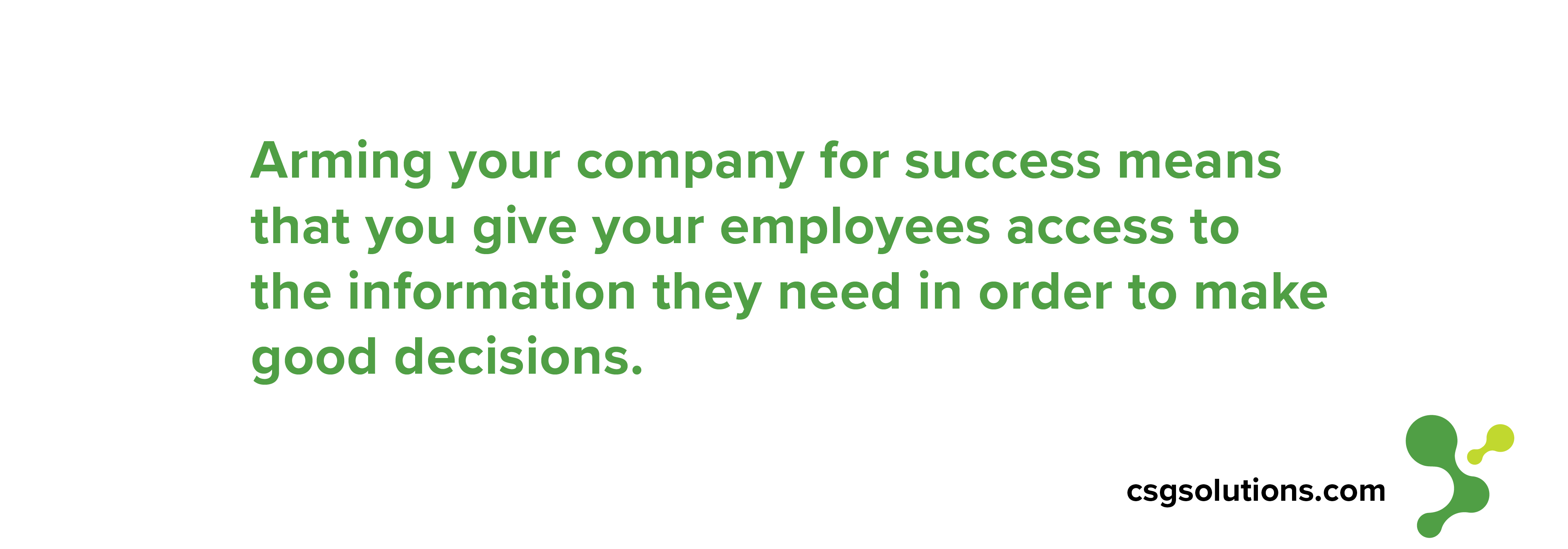
Yes, trust can be built with demonstration of responsibility and consistent growth, but start by giving your employees access, education, the benefit of the doubt, and then (if you don’t already) start trusting them to make more informed decisions. Give them leadership’s vote of confidence so that they can get excited about data, not thinking that you might be using it as a failsafe to make sure bad decisions aren’t made. It will naturally help you catch any mistakes or prevent assumptions when making decisions.
This doesn’t mean that every employee has to have access to your most valuable information; it should most definitely be governed. But the best way to encourage people to use data is to start with trusting them to make good decisions, trusting in your mutual value for data and desire for the company to succeed, and move forward from there. The big insights will come naturally as employees are equipped to use and discuss the data and as their managers consistently ask them to back up their choices with the numbers. It’s just effective, and it doesn’t hurt to give people a tool to carry out their responsibilities more informed than ever.
What’s the benefit to your company in this? Data insights won’t just have to come from one department! When they know how to use data, employees will be armed at all levels to make informed decisions. Your company will be firing on all cylinders. Employees that use data effectively and accomplish wins within their department by making good decisions will feel the impact of their effort and will feel even more valuable as a part of your company.
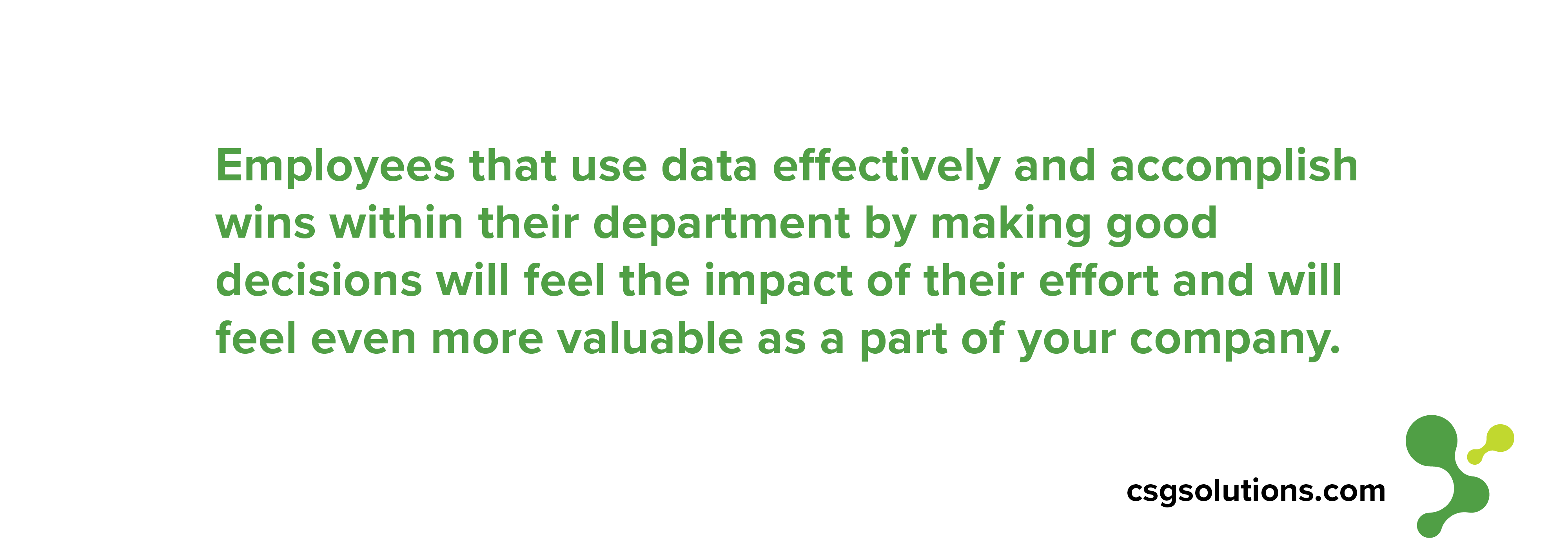
When everyone starts valuing data, everyone is equipped to be more successful within your company, and that feeling of reward and success becomes ingrained in your culture. Data paves the way for success, and when one person wins by making great decisions with data so does their team and the company. All around, data improves how people feel about the decisions they are making, because data access makes sure that every employee can see in real-time whether they are meeting the objectives they are responsible for or not.
Lastly, front-line employees usually hear the most from customers or clients about what’s not working at your company. When you show that you trust them and value their insight, you’re opening the door to solving problems that are important to your customers. Give the employees who will hear customer problems the ability to dive deeper into those complaints with data and potentially come up with a solution based on what they’ve heard from your clients. They have front-line knowledge, and your company will only benefit by equipping them to solidify and share what they know.
Trust your people with your data. Yes, it should be well governed, but don’t assume that insights are going to come from a certain team. Allow yourself to be surprised by where your insights and successful decisions come from. Allow every employee the opportunity to make more data-informed decisions. The source of insight will most likely surprise you. Trust is what makes that happen.
Commitment
Do you truly believe that data is your biggest strategic asset? Have you done the work to create buy-in in your team?
Don’t invest in a data analytics solution just because you know data is a trend that’s supposed to bring success. Invest in data because you truly believe in its value and understand exactly what it’s going to do for you. A trend-following mentality isn’t what will create buy-in in your team or get you the ROI you want; a committed, data-trusting mentality will.
Your team has to know you believe in data as the most valuable strategic asset, and they have to know why you think that. They need to know the understanding behind your commitment. That knowledge being shared will cause them to become more committed to data themselves.
It’s safe to assume a company wouldn’t invest in something unless leadership didn’t think it will produce their ROI, so communicate that reasoning with your team. Have them read what you’ve read. Share your decision-making process. Share what’s in it for them. Most of your employees’ understanding of the importance of data generally will come through their Tableau training sessions, but they’ll still need to hear personally about leadership’s commitment to viewing data as the company’s most important asset has to be consistent. They’ll need to be reminded of this in word and action from the moment they start training and for years to come until your data culture is clearly established.
How will this commitment be apparent after the initial Tableau training is over? Leadership will continually monitor how employees are using data and if data use aligns with strategic business goals. There should be an assigned executive to monitor whether your analytics efforts are supporting overall goals. This will be their role year after year as well, not just for a few months after Tableau is installed. Employees will know that you believe analytics is essential because they’ll see that someone in leadership is intentionally responsible for following up on its use and success.
Beyond the executive who is responsible for monitoring and reporting data use, other leaders should consistently discuss the facts around any topic, always bringing the conversation back to the data. For example, a CEO should ask project managers to share certain Tableau workbooks with them regularly in order to follow up on assigned goals. This would cause their project managers to identify the data necessary to achieving that goal and to continually stay in touch with those data sets until it is completed. Just by having to share a workbook regularly with a higher-up, that employee sees that data is a priority and is essential. This increases employees’ commitment to using data as well.
The Harvard Business Review suggests that leadership devotes thirty minutes at the beginning of every meeting to discussing purely the facts around the subject of the meeting. This would clearly show employees that assessing the data is a constant priority of their leaders, and this is where data truly begins to become a value of your company’s culture, not just a program available to employees on their desktop. Leadership sets the pace for how the rest of the organization uses data and includes it in their conversations and, ultimately, decisions.
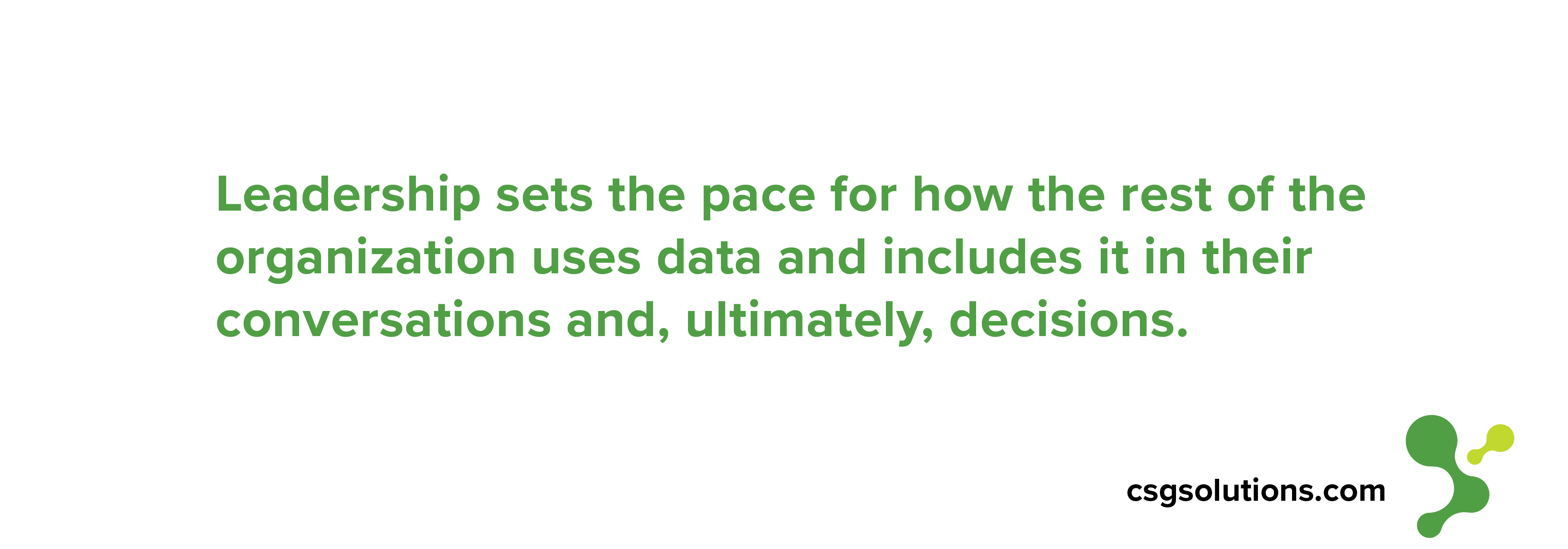
Leaders must think it’s worth it to stop and assess the facts, and then they need to set the example by doing it. They need to be committed to not making ’gut-feeling’ decisions unless they’ve explored the data. If they don’t have the data they need to make an informed decision, they need to identify what data is missing that still needs to be made available. Knowing what data you don’t have still moves your company toward the goal in a data-driven way. It shows employees that leaders won’t make a big or small decision unless they have the right information in front of them, and that they’re committed to making available the information that's necessary for success.

This is where your goals start aligning with your processes. When executives set goals for their teams, they should make sure they have all the data lined up for team members to run toward those goals with the most information possible. This will also allow leadership to follow up on the success of any initiative.
Leadership shouldn’t unleash an objective until the data to measure the success or failure of that objective is available. They should value data enough to take the time to get the correct data and make it available to themselves and their employees. They know that they won’t be able to accomplish their goals as successfully if they don’t have access to the right data related to that goal. They know they will need information to pivot if they’re not seeing results, and without that information made available they won’t move forward.
That’s a data-focused leadership team. And this value for data from leadership will set the pace for how every other employee thinks about making decisions. If their boss won’t make a decision without knowing all of the factors and history behind it that’s available through data, they probably won’t either.
Think about how this equips employees as well. If something goes wrong while they’re striving toward a goal given to them by their boss, an employee with access to data can have confidence that they’ll be able to communicate exactly how or why something didn’t succeed and already decide how to pivot for the next time they go for it! They can walk into a meeting with a superior with confidence and a solution already in mind!
This gives employees so much more confidence in project reviews and when it comes time to assess their performance. If they can back up their decisions with data, identify any problems or issues, and self-correct all because they have data, then you’ve successfully created a data-driven culture in your company.
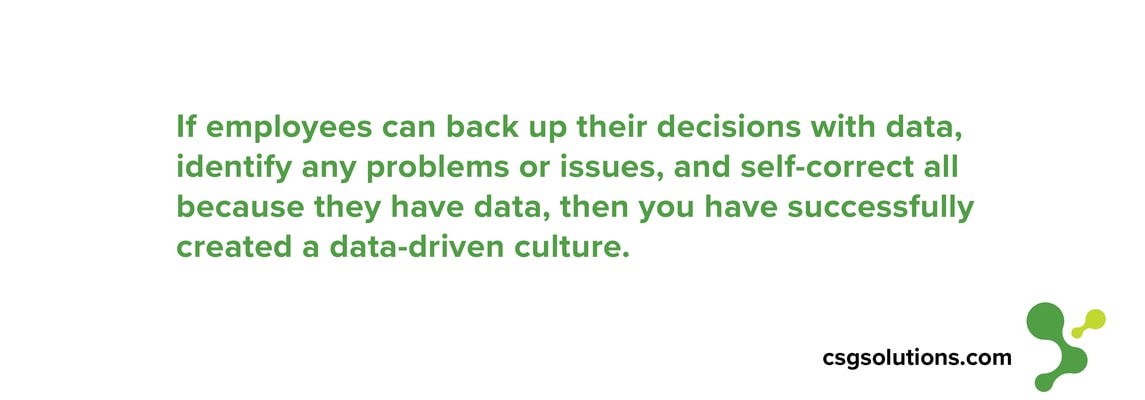
One last important way to show that your company is committed to analytics from the bottom to the top is to have directors attend Tableau training with their team. This strongly shows that Tableau isn’t just for one level of employee. It is valuable enough for leadership to spend time on it and know the ins-and-outs as a user, not just as a manager who will ask questions about Tableau without knowing how to use it. This creates buy-in. If the CEO knows how to look at the numbers and employees do too, looking into data is clearly a priority. It is extremely affirming as a team to know that your director values something that you’re about to spend a lot of time learning. Training is a key time to connect as a team and move forward with a data focus together, and the commitment of leadership builds the key element of trust discussed earlier.
Talent
Is using data effectively a part of peoples’ job description? And whose? Is it a part of how your company hires? Trains? Defines and redefines roles? Tableau says themselves that “A data culture is made up of data people… If they don’t understand how to work with data, they can’t be data-driven.”
The transformation of your workforce comes by training the talent that you already have, by updating HR processes and responsibilities to make sure you’re looking for people who are experienced with data when hiring, and by rewarding employees who consistently use data successfully. This will lead to a team that is enthusiastic about looking into the data, not just complying with a new company initiative.
Organizations are often surprised to find that, when it comes to training sessions, employees are more enthusiastic than they anticipated about growing their skills in Tableau. They know and have heard about how useful and necessary it is, so they’re energized to learn how to pull out all the stops and get the most out of their Tableau Dashboard. Likewise, if effective training is in place it should be easier to transform most of your current talent into a team of data-focused people and then add to that culture when you hire. When hiring, look for people who are confident in their ability to find the right data, analyze how that will impact their work, and communicate what they find.
Sharing
Your training sessions are just the starting point for developing the community around data that brings success at scale. After training, employees’ sense of community should be consistently fostered with data-focused training meetings as well as through messaging groups and portals that your company makes available to all employees who use Tableau. All of these opportunities for interaction will allow people to organically pass on best practices and ask for input from more experienced users.
In companies that have successfully scaled their analytics, when people ask questions, more experienced users respond quickly because they know how having access to analytics has helped them do their job better. People are excited to learn how to use Tableau, and when they start to see wins and discover insights personally, they get excited to share that with newer users. With the right opportunities for people to connect quickly and easily, the desire to share data and tips for using Tableau comes effortlessly.
It is essential, though, that space is created for this sharing to happen. The time for meetings and the time for continued team training sessions must be set aside. And channels for communication must be open so that employees can quickly share insights or ask a question and have it answered. Many companies accomplish this quick communication by setting up a Slack channel that includes all Tableau users in the company. Be sure to check out our blogpost on building community around data to get more ideas of how this could work for your company.
#teamcsg loves being involved in continuous training in order to help build that community. Especially if your company doesn’t have a lot of internal expert users yet, we can be a resource to provide extra training on Tableau’s features, even long after employees are initially trained. What matters most is that you continue showing your employees that data is a priority and that you continue giving them opportunities to connect and share how they are using analytics. If there’s any way we can help you foster that community or provide ongoing training, feel free to reach out.
Mindset
Last but surely not least, every employee from top to bottom should have a mindset that prioritizes data above all else. This means that everyone prioritizes data over intuition, anecdotes, or rank.
Do your leaders believe that following the data is more important than following their own idea or desire to see how that idea turns out? Data creates a level playing field. Anyone who understands how to look at data can discover an insight, have a good idea, or suggest that a current initiative doesn’t support business objectives. If it’s in the data, it doesn’t have to come from the leadership team.
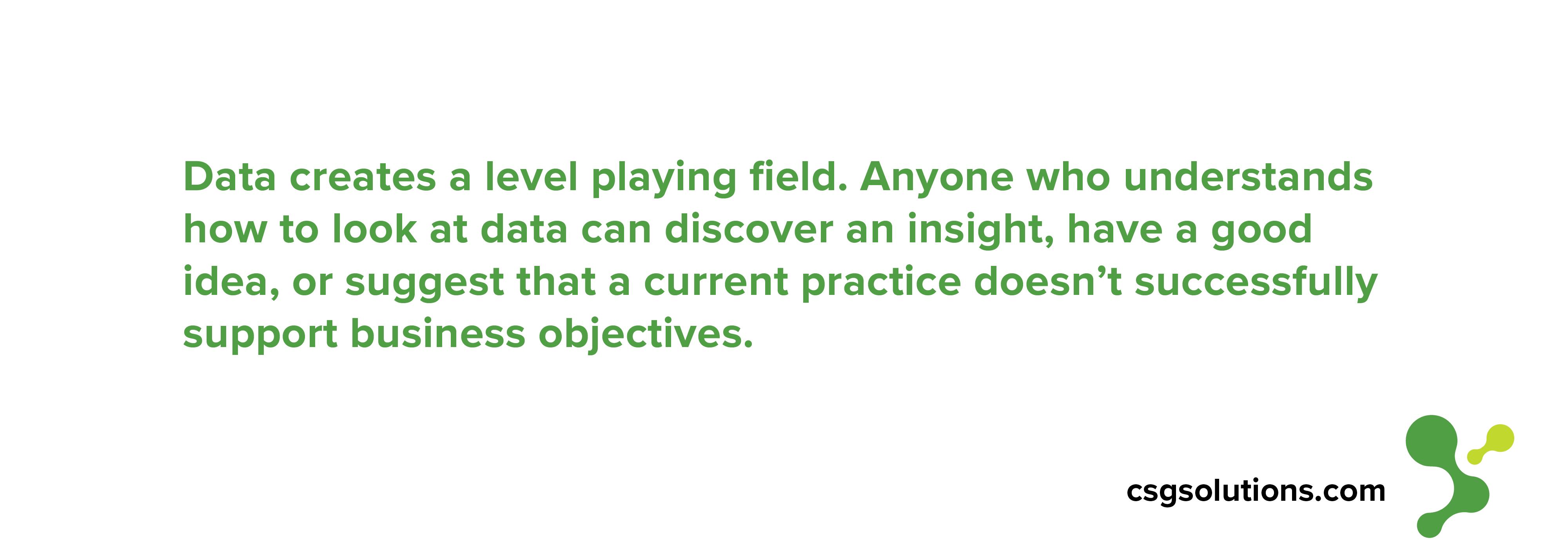
Likewise, when your team is enthusiastic about data, discussions become more open and innovative. You can consistently talk as a team about whether outcomes are being met based on the metrics. Employees know that you’ll be able to measure their success and the company’s success, so they’re motivated to contribute, perform well, and be a part of the progress.
Anyone can challenge an idea with data when they’re given access to it. Data allows any employee to easily see what is or isn’t working and bring it to the attention of leadership. When you have more eyes on your company’s successes and shortcomings, that’s never a bad thing. If you’re succeeding at meeting your organizational objectives, every employee with access to the data will be able to see that. And if goals aren’t being met, every employee will be equipped and curious to wonder why the gap hasn’t been bridged and look for a solution.
When everyone is equipped with a data mindset, a solution for greater success can come from any employee. This mindset must permeate all levels of the organization. With that in mind, be sure to share this value of a company-wide data mindset with your leadership so that they know to expect that any employee can come up with an insight, and they can partner with you to create a culture that promotes successful analytics at scale. Leaders should know ahead of time that it’s a part of their role to encourage discussions where current ideas and assumptions are challenged with data, and this equips leaders to spearhead those types of discussions with enthusiasm.
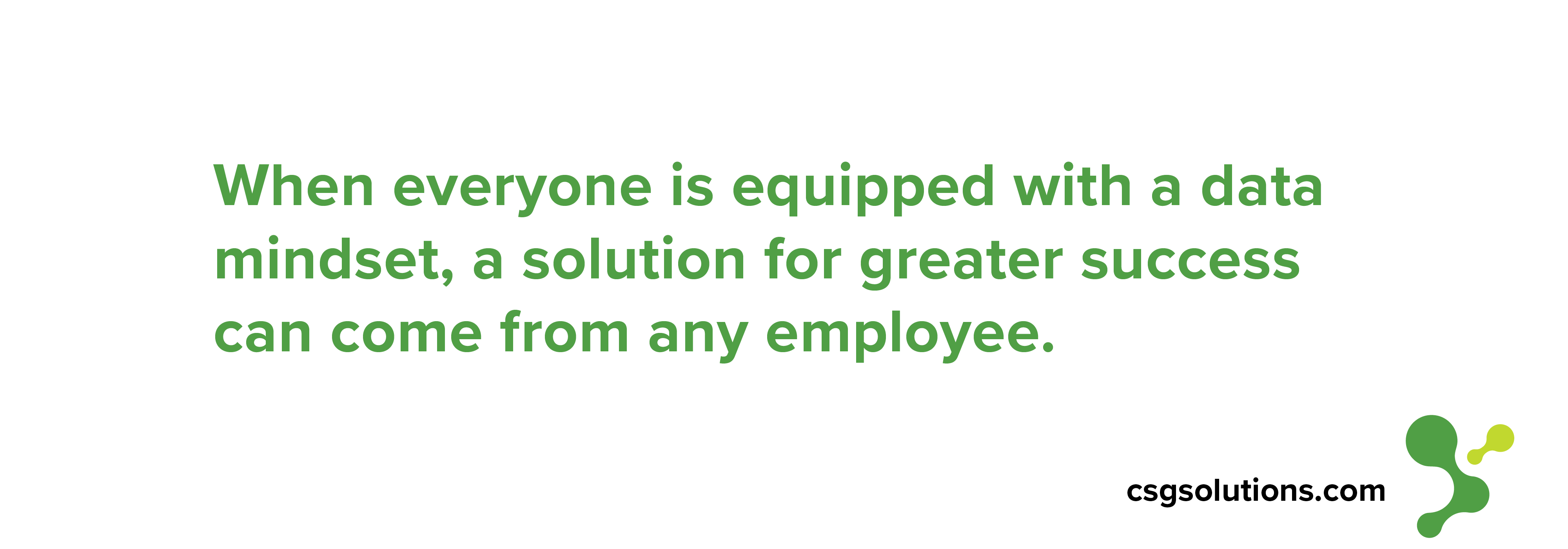
The shift to a data culture will take more commitment than just installing the software, but we promise that you will see greater results in the long-term for your company. Think, for example, about a car that can drive on autopilot. Consider the level of accuracy that it would have if it had only three or four cameras and sensors to take information from. And then consider if the car had thirty or even fifty sensors. It’s ability to sense its direction and then assess and correct itself would increase significantly.
When you are committed to investing in creating a data culture among all employees at your company, you are adding sensors to your company’s ability to correct itself. With more opportunities for correction, you are increasing your chance of success. This comes when your company equips every employee to be a part of your data culture, and when you remove the roadblocks to analytics at scale by making these five components of a priority. Communicate these values to leadership at the very beginning of your analytics investment. Make sure they’re a priority, make sure they’re discussed and put into practice regularly, and the culture will come with time and consistency.
Create a data-driven company culture.
Read our article to learn how effective training maximizes your tableau investment.


